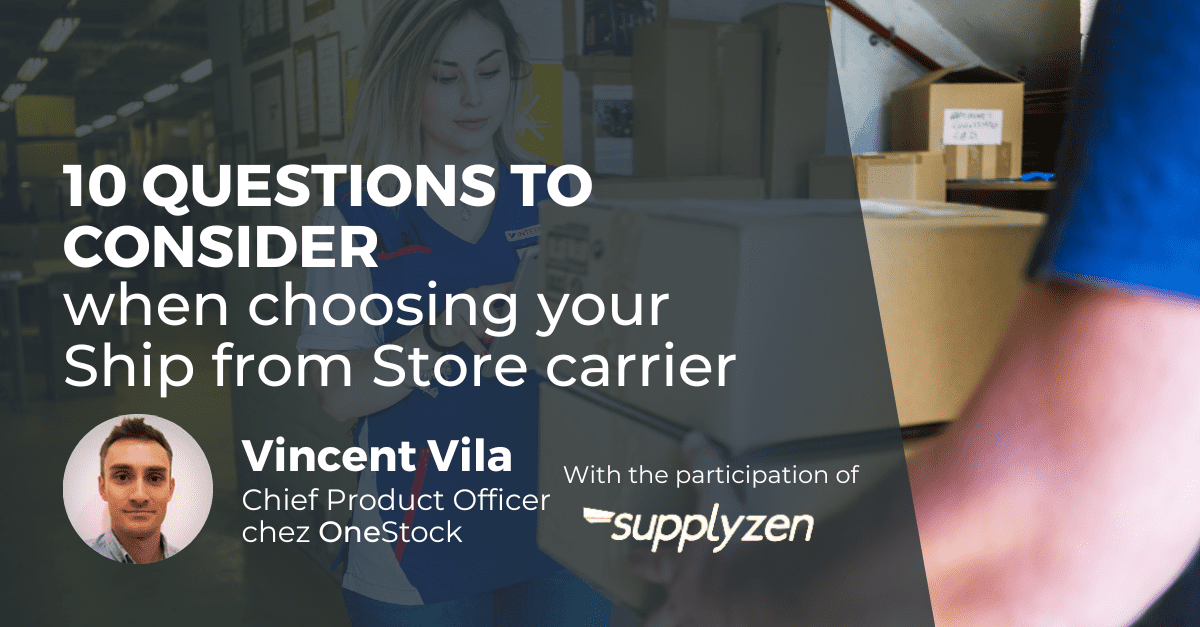
10 questions to consider when choosing your Ship from Store carrier
Ship from Store allows retailers to significantly increase stock available for sale on their website whilst also multiplying the number of shipping points for their products. This means retailers need to rethink their shipping offer accordingly.
Choosing the right Ship from Store carriers is essential. Discover the questions Supplyzen, the logistics and supply chain expert, thinks you should consider to ensure you make the right choice.
1. What package sizes will the stores have to ship?
Every carrier has its speciality! To make a first selection among all the available carriers, it is essential to determine which package formats will be sent from the stores: envelopes, standard packages, non-standard packages, etc.
As the package sizes are closely linked to the types of items sold in-store, they will also depend on the products that will be available via Ship from Store.
2. What is expected from the carrier? Are any special services required?
Implementing Ship from Store provides retailers with the opportunity to offer new services to customers. Firstly, these services need to be identified, taking into account their potential unavailability and price variations – depending on the type of delivery: national, local, international – and the type of items: standard, non-standard.
Some of the delivery options and services that can be offered to customers are same-day delivery, appointment scheduling, home delivery, pick-up point delivery, locker delivery, proof of delivery, delivery tracking, pre-printed return slips, etc. In addition to these options, there are often questions about the environmental impact of deliveries.
It is also necessary to determine whether international shipping is relevant. In this case, it will be necessary to identify the appropriate carrier and to anticipate the potential frictions linked to customs (necessary documents, associated costs, etc.).
3. What tasks will be required of store associates?
Store associates will play a vital role in the smooth running of the Ship from Store solution. As they are heavily involved in both picking and packing, it is essential to facilitate their daily work and define where their responsibilities end.
Their mission begins with the capture of omnichannel orders. This is followed by in-store picking and the preparation of the packages, which requires printing a transport label supplied directly via the Order Management System (OMS). This operation is thus simplified for the employee, which limits the risk of errors. Only the parcel numbers need to be carefully saved for tracking.
Parcel collection is also a key point to consider – will store staff drop off the parcels themselves? Will a carrier come and collect the parcels directly from the store? Regarding this precise topic, it is also necessary to try to anticipate carrier disputes as much as possible to assist stores and consumers as best as possible.
4. How long should stores be given to prepare their parcels so that they can meet the required delivery times?
In today’s e-commerce environment, transparency in terms of delivery times is a key element of the online shopping experience.
Ship from Store can impact these delivery times, positively or negatively. It is therefore important to define realistic preparation times for the stores. These times will then be taken into account in the delivery promise made to the customer, also integrating collection days and times from the store or drop-off at a post office.
5. Should the delivery promise be the same as for orders shipped from the main warehouse?
Warehouses and stores have different order picking and delivery requirements. This may justify different delivery promises. Ship from Store may therefore allow or prevent additional services to be offered.
While the customer does not need to know the logistical details, the delivery promise made to him must be clear, reliable and above all realistic!
Each transportation project is different, mainly for Ship from Store. This involves a real study of demand and needs, followed by ongoing exchanges, particularly with the store teams. Henry Ford said “Getting together is a start, staying together is progress, working together is success”, we prove him right every day!
Jacques FERLAY – Head of Business Development and Customer Partnerships, Supplyzen
6. What store tools are available to implement Ship from Store?
Although Ship from Store is not very complex to deploy, it does require a minimum of equipment and tools.
Of course, you need to think about packaging: envelopes, plastic wrapping, cardboard boxes… As with all shipments, eco-friendly packaging will minimise the amount of waste while ensuring excellent protection. It is also ideal to have reusable packaging for returns.
Lastly, the IT equipment must be adapted to the stores and their specific processes: telephone, tablet, cash register, laptop, with or without a barcode reader, etc. The IT solution must be adapted to manage the processes and printouts as easily as possible.
7. What are the IT-related expectations, linked to carrier operations?
Both the selected carrier and the chosen system must be considered in their entirety.
Beyond a simple transport service, the solution must be integrated from an IT point of view to facilitate label creation, collection requests, returns and transport tracking.
8. What types of package collections does Ship from Store allow: daily or on-demand?
Transporters offer different types of collections, including daily and on-demand pick-ups. For each store, the most suitable solution must be chosen.
For example, daily collection may be appropriate for flagship stores, while others may not have parcels to send every day. Stores located in city centres or shopping malls, for example, may have limited collection options with certain carriers.
The collection method and frequency can be adapted by carefully assessing the volumes and recurrence of shipments for each store.
9. Are the carriers that handle warehouse orders able to meet the needs of Ship from Store or do new transporters need to be considered?
Given all the Ship from Store specifics discussed above, it seems clear that the carriers operating out of central stock are not always the most suitable.
Using the same carrier solutions would obviously have its advantages, in terms of cost, connectivity or tracking, but it is still best to consider all options.
10. What are the company’s expectations in terms of support for the stores, in terms of deployment and monitoring?
An important point to consider is that transportation does not stop once the parcel has been shipped! This is why the carrier solution must go beyond this and expectations regarding support and services must be carefully defined. The implementation of a carrier across a network of stores requires specific follow-up and the stores must have a dedicated contact to assist them in the event of collection problems.
An important point to consider is that transportation does not stop once the parcel has been shipped! This is why the carrier solution must go beyond this and expectations regarding support and services must be carefully defined. The implementation of a carrier across a network of stores requires specific follow-up and the stores must have a dedicated contact to assist them in the event of collection problems.
As the carrier is the only physical point of contact for web customers, expectations are high: tracking and anticipating problems and late deliveries are essential. It is crucial that carriers can proactively get in touch with the consumer and that the latter have reliable contact information in case of transport problems.



